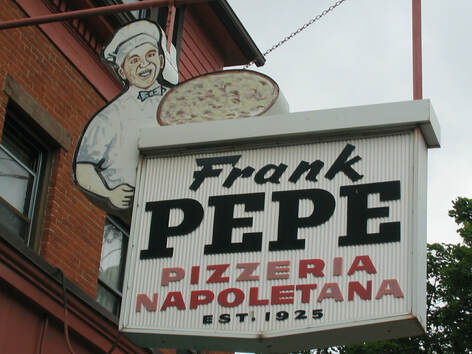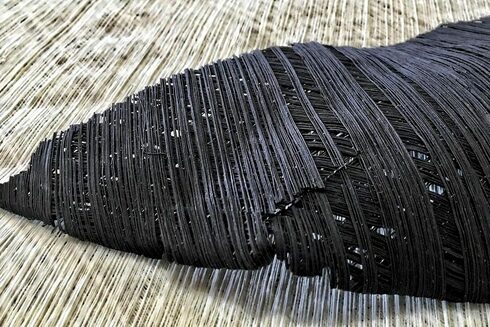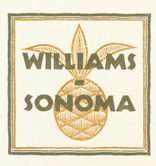|
Frank Pepe Pizzeria Napoletana is one of the oldest and best-known pizzerias in the United States. Known by locals as simply Pepe’s, its original location is in the Wooster Square neighborhood of New Haven, CT.  This Connecticut landmark pizzeria was founded in 1925 by Frank Pepe, born in the Amalfi Coast town of Maiori in 1893. As a poor, illiterate immigrant, he came to the U.S. when he was 16 years old and managed to get a job at a New Haven factory until World War I broke out when he returned to his homeland to fight in defense of Italy. After the war he married Filomena Volpi in Maiori and returned to America to start their new lives. Frank at first worked for Genneroso Muro's macaroni shop and next for Bread baker, Tony Apicella where he fell in love with and learned the art of making bread. Once he had learned the art of bread-making, he opened his own bakery at the original Wooster Street location where Frank Pepe’s the Spot (operated by the Boccamiello family) sits today. At first he started delivering bread to his customers, but because of his lack of reading and writing skills, he found it difficult to keep the addresses in order. What to do? Invent a business where the customers come to you. His wife Filomena had learned to read and write which helped enormously for their next adventure... in 1925 they decided to start making something very new to Americans--Pizza! The local Italian-Americans, still today, call it "ah-BEETZ". They offered two types: Tomato Pie with grated cheese, garlic, oregano and olive oil and a second with anchovy. Their "Original Tomato Pie" is still offered at the 157 Wooster Street location, as well as at the others. Keep in mind, however, Pepe's Tomato Pie is thin-crusted and round, very unlike the Philadephia/Trenton are Tomato Pie which is thick, bready and square.  Frank Pepe originated the New Haven-style, thin crust pizza baked in brick ovens fired by coke, a byproduct of coal. In the late 1960’s coke became unavailable, so he converted the ovens to being coal fired, which gives a very distinct, smokey quality to the darker parts of the crust. As time went on, Pepe's developed another signature pizza, the White Clam Pizza. This later innovation was an homage to Frank Pepe having originally served raw little neck clams on the half shell from Rhode Island as an appetizer. Today, it's one of the most popular choices on their menu. If you are a confessed pizza addict and want to eat a little bit of pizza history, stop at a Frank Pepe's Pizzeria... there are locations from Yonkers, NY throughout Connecticut and all the way Chestnut Hill just west of Boston. --Jerry Finzi Copyright 2019 Jerry Finzi/GrandVoyageItaly.com - All rights reserved. Article not for reproduction without expressed permission. In Palermo there is a type of pizza that is similar to the thick, bready crust of focaccia, but unlike focaccia, it has tomato sauce on the top. Ingredients are usually put on in a reverse fashion--the mozzarella or caciocavallo cheese placed on the dough first with the sauce goes on top. What makes this pizza stand apart from others is the final topping: a healthy dusting of breadcrumbs, which turns this into a classic, Sicilian sfincione. There are derivatives of sfincione, like the tomato pies made around the Philadelphia and Trenton, New Jersey region. This cousin of sfincione is thick and bready, but has a solitary topping of thick tomato sauce with perhaps a sprinkling of grated parmesan cheese (if any) and is always served room temperature. Personally, the tomato pies I've had have been a bit too intense on tomato flavor. For my version of sfincione, I topped it with julienned slices of caciocavallo cheese and Italian style breadcrumbs. Of course, you can also put some stale ciabatta in a food processor and make a rough textured breadcrumb for the topping. I didn't overload my sfincione with breadcrumbs, but keep in mine, in Palermo they might put a fairly thick (1/4") topping of lightly toasted breadcrumbs on top. I made this during the late summer when I had an abundance of my Olivette Jaune heirloom tomatoes, so onto the top they went... Equipment Needed: 1-13x17" half sheet pan (dark colored to create a well baked crust) thin, cotton kitchen towel baking stone (better yet, a baking steel) Proofing the yeast 1 tablespoon active yeast 1 teaspoon sugar 1 - 1/2 cups water at 115F For the dough: 2-3 cups bread flour 1 teaspoon salt 1 tablespoon sugar 2 tablespoons extra virgin olive oil For the sauce: 28 ounce can crushed tomatoes (I recommend Tuttorosso brand) 4 small anchovies in oil 1 tablespoon sugar 2 tablespoons dry basil (or 8 large, fresh basil leaves, julienned) 2 tablespoons extra virgin olive oil Toppings: Thin slices of caciocavallo cheese (alternate, sharp provolone) 1-2 cups Italian style breadcrumbs (or 3 cups, rough chopped fresh breadcrumbs) 2 tablespoons Oregano (for mixing with bread crumbs) Yellow olive shaped tomatoes, halved Extra virgin olive oil Grated Parmigiano Reggiano or similar cheese Optional Toppings: caramelized onions, prosciutto, olives, pimentos, anchovies, fresh basil or oregano leaves. Making the Dough
To make the sauce:
 Putting together the Sfincione:
Slice your sfincione into squares or rectangles for serving with a simple salad and a glass of red Sicilian wine, such as Corvo Rosso. And don't forget, sfincione is traditionally served at Natale (Christmas) and the Italian father's day, la Festa di San Giuseppe on March 19th. Buon appetito! --Jerry Finzi You might also be interested in...
How to Make a Great Pizza Crust Making the Best Pizza Sauce Our Double-Crust Pizza Rustica! My New Pizza Steel Our Deep Dish Pizza! In the small Sardinian town of Nuoro, there are a very few women (you might count them on one hand) who still know how to make what many say is the rarest type of pasta in Sardinia Italy and perhaps the whole world... Su filindeu (in Sardinian dialect), and in Italian, Fili di Dio, can be translated as either Wires, Yarns or Threads of God. You might think of this pasta as the elevated and rarer version of angel hair pasta. Filindeu is tied to a religious ritual celebrated in the region of Nuoro in the town of Lula. La Festa di San Francesco is held on May 1st at the Chiesa della Solitudine di Nuoro. Oddly, this celebration is tied to a murder in the year 800 AD. Accused of murder and being hunted down for his crime, a young man claimed innocence and took refuge in a cave about 15 miles from Nuoro. He was discovered, brought to trial and miraculously (to him) declared innocent. He had prayed to Saint Francis during his time of refuge in the cave and thus built a shrine in the cave in honor of his patron saint. In autumn on October 4th, there is a second procession to the cave and shrine followed by a celebratory feast of filindeu. The dough to make this special pasta is durum semolina, water and a bit of salt, without leavening. It is then kneaded for a very long time to stretch the gluten, making it very soft with amazing elasticity--the key to making the long strands. The dough is rolled by hand into 8 long, thin snakes, which are folded, halved and pulled, only to be folded and stretched again--32 times in total--resulting in 256 thread-like thin bundles of parallel groups of pasta. These threads are then stretched across a large, flat tray called a fundu, traditionally woven from leaves of the local asphodel plant (a member of the lily family), often used in basket-making. To aide in the stretching, the dough is occasionally dipped in salt water--the timing of this sensed only by the experience of the artisan making the pasta. This process is repeated until a single layer of "threads" cover the entire fundu. the basket is then rotated by about 60° with another layers of pasta "threads" laid down. This is repeated a third time creating three crisscrossed layers of "threads". The tray is placed in the sun to dry causing the three layers to stick together while creating a stiff fabric of pasta looking very much like a course textured cheesecloth. For the feast, the filindeu is broken into pieces and put in boiling mutton broth. Grated pecorino (sheep) cheese is added to complete the soup. I don't know about you, but I've always loved my soup loaded with noodles--perfect for when the cold weather hits. If you're ever in Sardinia, look for packages of filindeu shards. Some have realized that this is a real Sardinian treasure and are trying to expand the availability of this pasta. Sadly, this unique pasta technique is in danger of becoming extinct. For example, Only one of Paula Abraini’s two daughters knows basic technique but seem uninterested in continuing the tradition. Abraini also has no granddaughters to pass he skills along to. The two other women in Abraini’s family who still carry on the tradition are both in their 50s and also have no successors to this tradition. Paula Abriani was so concerned about the techniques of making su filindeu disappearing, that she went to the local government to see if there was some money to open a school. There wasn't. Then she tried to teach young locals to make it in her home--they got discouraged with its complexity and gave up. Luckily, she was invited to Rome by the gourmet magazine Gambero Rosso so they could film her techniques for posterity. She has also started making filindeu for several restaurants who serve her amazing pasta to clients from around the world. The preservation of her tradition is looking a bit brighter! If you're traveling to Nuoro, search out the women who still make this pasta for a lesson on how it's done. They have learned the skill from their mothers who learned it from their mothers and so on, going back three hundred years. Ask, plead or beg for a lesson from either Paola Abraini, Salvatora Pisano or Grazia Selis. If you're lucky enough to get a little lesson from them, don't forget to say "thank you" in Sarda, the Sardinian dialect... grazie meda! And give them a solemn promise that you will pass along their skills. --Jerry Finzi You might also be interested in...
How to Cook Pasta: 101 Map of Regional Pasta Everything You Ever Wanted to Know about Pasta Sexy Pasta Shapes! The LIGHT Way to Make Potato Gnocchi Canederli: The Italian Matzo Ball Does Adding Water to a Pasta Sauce Make a Difference? Making Fresh Pasta: A Family Tradition Test Driving the Kitchenaid Pasta Extruder Spaghetti the Grows on Trees?
When autumn comes to Tuscany, you will be able to enjoy Castagnaccio, a torta rustica made with chestnut flour and olive oil that has ancient origins. In the 1500s it was well known in Tuscany as cucina povera, a dish prepared by poor, peasant farmers and shepherds. Chestnuts were plentiful in the hills of the Apennines and easy to harvest, not only for its nutritious flesh but also for chestnut flour. Chestnuts (castagne) are rich in protein, calcium and vitamin A.
This torta can also be called baldino, ghirighio, toppone or pattona, depending on where you are in Italy. Local variations may include other ingredients, such as rosemary, orange peel and fennel seeds. There is even one romantic legend that says when its perfumed with rosemary, Castagnaccio is a powerful love potion--making and serving it the object of your affections will make them fall in love with you, and ask for your hand in marriage. Perhaps this is more than just a dish served during Natale, but also appropriate for Valentine's Day! In its earliest conception, it was an easy way to make a portable food (like an energy bar) that stored well for long periods, helping sustain poor contadini during long, harsh winters. According to Ortensio Landi (1553) in his “Commentario delle più notabili et mostruose cose d’Italia e di altri luoghi“ ("Commentary on the most notable and monstrous things of Italy and of other places"), he traced its origins to a man called Pilade from Lucca. By the nineteenth century however, the addition of pignoli and dried fruits morphed this spiced cake into a dessert deserving of the Christmas season and its popularity spread to Liguria, Piedmont and Emilia Romagna and even on the nearby French island of Corsica. Today you will find castagnaccio just about everywhere in Italy during Natale festivities. Keeping with Tuscan tastes, typically, no sugar is added because of the inherent sweetness in the chestnuts themselves and the addition of dried fruit and raisins. Castagnaccio is often served with ricotta, honey or sweet wines such as Vin Santo. 
Ingredients
Optional: You can soak the raisins in rum, Amaretto or orange liquor instead of water for a more adult version.
Directions

Serve with a glass of Vin Santo, and a dollop of fresh ricotta on the side, and drizzle both with a Tuscan honey of your choice.
Buon appetito! --Jerry Finzi
For further reading:
Chestnuts: The Italian Love Affair with Castagne Foto del Giorno: Chestnut Vendor Harvest Festivals in Italy: From Grapes to Wine, and More
Calling all Milanese! Attenzione a tutti i Milanesi! The new Starbucks is opening today on Piazza Curdusio in Milano! The location is in the old post office... Please... visit the store, order one of their "coffees" and perhaps shoot a video of your visit and post it here on GVI... Tell us what you think about the "Starbucks Experience". Take photos of their menu and prices--and their giant sized offerings. Are the high prices (and high sugar & fat content) really worth a few couches and free WiFi?
GVI wants to know, and will include your impressions in an upcoming article. Let's really take a look to see if Italians really want Starbucks in the land of Moka pots and espresso. You can contact us here, or send us email via our Grand Voyage Italy Facebook page. --GVI For further reading: Will Starbucks Make it in Italy, Home of the Quick, Tiny Espresso Shot? You know, I always thought I'd have a problem eating weird things if I ever traveled in the Orient. I'm a person with a fairly narrow palate... I admit it. Even my 14 year old, Lucas has a much broader palate than I do. I like what I like and won't try what I know I don't like. I'm old enough to say that I have tried lots of stuff--for instance, I hate caviar and cooked spinach makes me gag. I know what I can't stomach. In my research and travels about Italy, I've come across things that I wouldn't eat if you paid me. Some things I'll try--once--while others... well, you just sort of know to stay clear. Still, we have to respect the culinary traditions of our Italian heritage and try not to be so grossed out by it. Food is fuel--fuel is food. In Italy, nothing goes to waste--not beast or flora. So, I hope you pardon me as I poke a little fun at some of Italy's oddest culinary creations--even though I may tease a bit, I still want to honor the complexities if la Cucina Italiana... In ancient Rome peacock eggs, boiled ostrich and stewed parrots were common on menus.  Stuffed Mice There is a protected, fluffy tailed species of dormice (Glis glis or Ghiro) that have been eaten since the days the Caesars ran things. Down in Calabria the rodents are still stuffed and chomped on. They are stuffed with meat, nuts, raisins, onions and spices. You can imagine little squeaks as you take a bite. I have no idea what they do with all those cute fluffy tails. Ghiri alla pizzaiola : Ingredients : . 2 Ghires, 50 g of lard, 50g of pancetta, gr 600 gr peeled tomatoes, 1 tablespoon of chopped parsley, 1 tablespoon of oregano, 1 tablespoon extra virgin olive oil, 1/2 teaspoon of salt Engage the dormice lengthwise, peel them, quickly remove the bladder without breaking it and leave it in running water for a few hours. Rinse them and blanch in boiling water for a couple of minutes. Chop the lard and the bacon and put the mince in the belly of the dormice. Place them in a large pan, pour the oil and cover with chopped tomatoes, parsley and minced garlic, oregano and salt. Cook over moderate heat, keeping the pan tightly closed with the lid.  Riccota Forte (or Scanta) The Pugliese are a resourceful bunch. I know--mu Dad was from Puglia. Many of you may know that ricotta means twice cooked or re-cooked... basically, ricotta is a by-product of normal, everyday cheese making. You take the little bit of whey left over, add an acid, boil it and presto, you have ricotta cheese. It's a fresh cheese and should be eaten within a couple of days. When it dries out, the frugal Pugliese add salt, and let it dry even more into Ricotta Salada (one of my favorite cheeses). But some go even further. Some just let it go bad... and stinky... and acrid, turning it into a Apulian delicacy called Ricotta Forte, or Scanta. Many think this acrid, foul smelling cheese is worse than any other stinky cheese they've even eaten--but in a good way. We tried it during our stay in trullo B&B outside of Alberobello. Yes, it stinks, and our host told us how it's just kept in a dark, un-refrigerated place (under his sink) to grow more bacteria and even sometimes microscopic worms--but we actually liked it! (But it did burn my eyes a tad).  It's the kind of taste that shocks your eyes open, assaults your nose but somehow in the end pleases your palate. It's also a surprise when you are first introduced to it in a plain jar that looks like it's your Aunt's 1950s era home brew face cream. Enjoy. (Oh, just don't get it on anything sweet... I got it on some Nutella and bread by mistake and nearly got whiplash when I popped it in my mouth.)  Casu Marzu or Formaggio Marcio (Rotten Cheese), with Maggots Casu Marzu is a sheeps' milk cheese from Sardinia and Corsica (they call it Casgio Merzu) that actually contains maggots--live ones. Most cheeses rely on fermentation and bacteria to develop their flavor, but this cheese relies on actual decomposition caused by the Cheese Fly larvae. The texture is an oozing, seeping liquid, essentially caused by... well... maggot poop. Some people eat this stuff with the larvae, some will tickle the cheese, causing the larvae to be disturbed enough to actually jump out... as much as 6 inches! The daring who have tasted it say this muck is so acidic that it leaves an after taste in your mouth for hours afterward. I recall a cheese like this in France years ago--I wouldn't go near that either!  Batarga From what I hear, battarga is definitely an acquired taste that's at least a thousand years old and perhaps more ancient than that. It's made from the roe (fish egg) pouch of either grey mullet or Atlantic blue-fin tuna. The roe pouch is manipulated by hand to get rid of any air bubbles and then cured in sea salt for several weeks. After curing, the result is a hard, dried salty slab which is usually (but not always) coated in beeswax.  To use it, you grate some on top of pasta or on top of crostini (toasted bread) and drizzled with olive oil. It also can be used as a main ingredient along with garlic for tomato sauce. It has a tremendously long shelf life and is often smuggled out of Italy due to its high price--up to $140 a pound! You can actually order some on AMAZON.  Colatura di Alici, Fish Sauce In ancient Roman times there was a fishy concoction called garum, a clear sauce made from salting and compression of various types of fish. The clear garum on top was used by the upper classes, while the sludge left over, called allec, was used by the lower classes to add flavor to polenta, porridge or on bread. Today there is a modern version called Colatura di Alici made in one of my favorite villages on the Amalfi Coast, Cetera (click the photo to see it on Amazon). The first time I took a tour of Cetera at ground level on Google Earth I started seeing barrels and wondered why this village had so many. It's a fairly simple recipe... 
The golden liquid is prized in Italy and is used to flavor all sorts of dishes. Watch the video of Colatura being made... 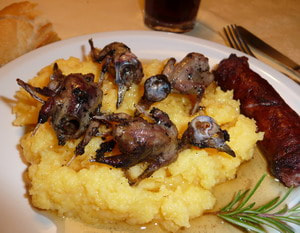 Polenta Uccelli (Polenta with Songbirds, or Polenta e Osei) Yes, the same song birds that will awaken you on a misty Tuscan morning are being shot or captured in hanging nets by hunters to supply their illegal bounty to select restaurants throughout Italy. Yes, it is illegal, but those doing it consider the practice as being furbo (crafty). They make a living while carrying on a tradition. In Tuscany the birds are flambéed, in Sardinia they are boiled and preserved, in the Veneto rolled in pork belly and fried. Perhaps the best known version is in Lombardy where they are grilled or fried. It seems this is an elite recipe item in Italy. Ladies and gents get dressed up in all their finery and make an event out of eating these little skylarks, goldfinches and other types of song birds. Our hot air balloon pilot, Stefano told us they shoot anything in Italy, especially song birds, so much so that some species are becoming endangered. Oddly, we flew directly over some "hunters" in their treetop blind, releasing pigeons only to shoot them a moment or two later. The little tweetys are usually stuffed with pork, beef, rabbit or even other birds. They are served with their heads and beaks on top of polenta, an attempt to mimic a bird's nest.  To illustrate how much Italians love this special dish, certain pasticcerie have created a legal version: a dessert called Polenta e Osei, made to look just like the real dish. It's made of a soft light sponge cake filled with hazelnut cream that is rolled in a yellow fondant. On top are little chocolate birds made from chocolate marzipan. You can find this in the town of Bergamo. As for the real song bird dish, the macho thing is to pick up the birdie by the beak and leave nothing... devouring bones, beak and all. At least they are not as ruthless as a similar dish I saw in France years ago--where they drown the birds in the local brandy, then when eating drape a napkin over their heads and the dish to inhale the fragrances and crunch down on the bird, apparently head hidden in shame.  Pajata (Cheese from Cow's Intestines) This is either a Roman dish or what the Devil himself would order up. A young, milk fed (no grass feed) calf is slaughtered, and besides getting veal, brains and other delicacies from it, the intestines are used to make this delicacy--pajata. The intestines are washed, but not emptied. When cooked, the partially-digested milk inside turns into a thick, funky cheesy substance which is used as a pasta sauce, and often served on its own with crostata. No grazie! 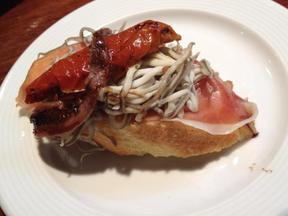 Cieche (Baby eels) Cieche are baby eels that migrate upriver after being born in the sea. The name, Cieche (cieco) literally means blind – these babies have no eyes. In coastal areas of Tuscany, cieche are usually fried or boiled alive. Just be careful they don't jump out when you're trying to dump them into the boiling water or saute pan. 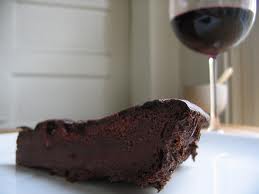 Tuscan Blood Torte Enough said. A torte or cake made from the blood of pigs? I've tried Argentinian blood sausage and British blood sausage, and if the flavor is anything close to what I experienced, I would never go near this stuff. But this recipe contains cocoa and has a chocolate taste, albeit a bit more... er... pungent because of the pig's blood it contains. The pudding used is similar to Sanguinaccio Dolce, a traditional recipe in the South made when a pig is slaughtered using the pig's blood, chocolate, raisins pignoli and sugar. This is an example of the Italian philosophy that nothing goes to waste, not even the last drops of blood. Watch the video below from the Two Greedy Italians series where Gennaro shows how they make the pudding (at 9:45). 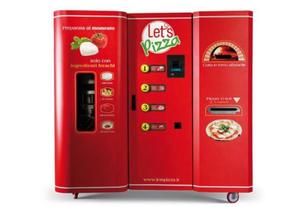 Vending Machine Pizza As all of the above proves, Italians will eat anything... even pizza made totally inside a robotic vending machine. Not THAT's a real crime! Let's Pizza machines were initially designed and manufactured in Northern Italy. It offers a choice of four kinds of pies, and makes the pizza while you watch the whole process through windows--adding water to flour, kneading the dough, placing the sauce and toppings, and baking the pizza via infrared oven in just 2.5 minutes. It can produce 90 to 100 pizzas before it needs to be refilled. Ugh. Just because you can, doesn't mean you should!  Ok, so vending machine pizza isn't such a big deal, but how about (suspenseful music...) Gatto in Umido? This translates as "Stewed Cat"! Calmati, Betty White... "Gatto in Umido" is simply Stewed Cat-Fish. As I said, we all have to keep an open mind. I hope you enjoyed this look into the traditions of culinary Italy. Via la Cucina Italiana! --Jerry Finzi Did you ever wonder about the everyday life of Renaissance Masters, like Michelangelo? Did you wonder if they took long walks or picnics? Did they go to the local taverns to kick back a few brews and relax with the guys? Did they attend sporting events or shop for bargains at the local flea market? How about their food? What did they eat and how did they do their shopping? Well, we can actually tell from this grocery shopping list written by Michelangelo himself in the 16th century. He ate anchovies, bread, two fennel soups, a herring (un aringa), four anchovies, tortelli, and wine (“un bocal di vino”), among other things. He drew the list as pictograms because his servant was illiterate. He would tell him what he wanted, "get the big loaf of bread, not the small one", but also sketch it so the servant could look at the images to refresh his memory while at the market. Experts say the list is for three separate meals. He drew bread rolls as simple circles--an easy shape for his servant to remember meant - bread. For another meal, he wanted two rolls but for another, six. The herring is sketched by itself, and bowls are filled with salad and anchovies. Two dishes of stewed fennel are shown side by side (perhaps he wasn't dining alone?). For the wine, he drew a small wine carafe next to a larger one--perhaps two types, one being an after dinner, sweet wine? The tortelli (tortellini) pasta were not drawn at all. Perhaps his servant's wife made them, something he obviously would never forget if the Master asked for some. Since the letter on the other side of the list was dated March 18, 1518, the meatless menu would make sense falling during the Lent period of fasting. Michelangelo couldn't eat meat, so it was bread, fish and veggies. Still, for its day, this was a nobleman's menu... Michelangelo was anything from a starving artist.
During this same year, Michelangelo had ordered many of his notes and sketches to be burned--the Renaissance method of shredding documents. It's amazing that this little take-out order managed to survive at all. This grocery list is archived at the Florence museum Casa Buonarroti, where one can find many of the artist’s handwritten notes, doodles and sketches. --Jerry Finzi Anthony Bourdain passed through the sieve of humanity recently with both accolades and "I told you so"s. He developed a seedly, tattoed, chain-smoking, underbelly-of-life, Kerouac-inspired public persona, even though he lived the privileged life of celebrity and wealth. Part beat poet, part philosopher, part Lower East Side. Some say he was a cook who couldn't, so he wrote about it. He was a vagabond, for sure. You could see signs of the depressive personality in his presentations... grim expressions, smoking, drinking, pensive poses... always searching. Occasional laughter but never much joy or bliss. Perhaps he found it. Perhaps not. He did show us the world and its food. That's something. --JF |
Archives
July 2023
Categories
All
|

